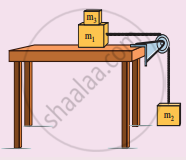Advertisements
Advertisements
प्रश्न
A long stick rests on the surface. A person standing 10 m away from the stick. With what minimum speed an object of mass 0.5 kg should he has thrown so that it hits the stick. (Assume the coefficient of kinetic friction is 0.7).
उत्तर
Given,
Distance (s) = 10 m
Mass of the object (m) = 0.5 kg
Coefficient of kinetic friction (µ) = 0.7
Work done in moving a body in horizontal surface ω
= µR × s = µmg × s
This work done is equal to initial kinetic energy of the object
`1/2mv^2` = µ mg s
∣`v^2`∣ = 2 µgs = 2 × 0.7 × 9.8 × 10
v2 = 14 × 9.8 = 137. 2
v = 11. 71 ms-1
APPEARS IN
संबंधित प्रश्न
An object of mass m begins to move on the plane inclined at an angle θ. The coefficient of static friction of inclined surfaces is µs. The maximum static friction experienced by the mass is ______
Explain various types of friction.
Suggest a few methods to reduce friction.
State the empirical laws of static and kinetic friction.
People often say “For every action, there is an equivalent opposite reaction”. Here they meant ‘action of a human’. Is it correct to apply Newton’s third law to human actions? What is mean by ‘action’ in Newton's third law? Give your arguments based on Newton’s laws.
Two masses m1 and m2 are connected with a string passing over a frictionless pulley fixed at the comer of the table as shown in the figure. The coefficient of static friction of mass m1 with the table is µs Calculate the minimum mass m3 that may be placed on m1 to prevent it from sliding. Check if m1 = 15 kg, m2 = 10 kg, m3 = 25 and µs = 0.2.

A block of mass 20 kg is sliding on a surface is inclined at an angle of 45° with the horizontal. What will be the acceleration of the block if the coefficient of kinetic friction between the block and the surface is 0.7?
Block A has a mass of 2 kg and block B has 20 kg. If the coefficient of kinetic friction between block B and the horizontal surface is 0.1, and B is accelerating towards the right with a = 2 m/s2, then the mass of the block C will be ______.
(g = 10 m/s2)

Starting from rest, a body slides down a 45° inclined plane in twice the time it takes to slide down the same distance in the absence of friction. The coefficient of friction between the body and the inclined plane is ______.
A body starts from rest on a long inclined plane of slope 45°. The coefficient of friction between the body and the plane varies as µ = 0.3 x, where x is distance travelled down the plane. The body will have maximum speed (for g = 10 m/s2) when x = ______.
